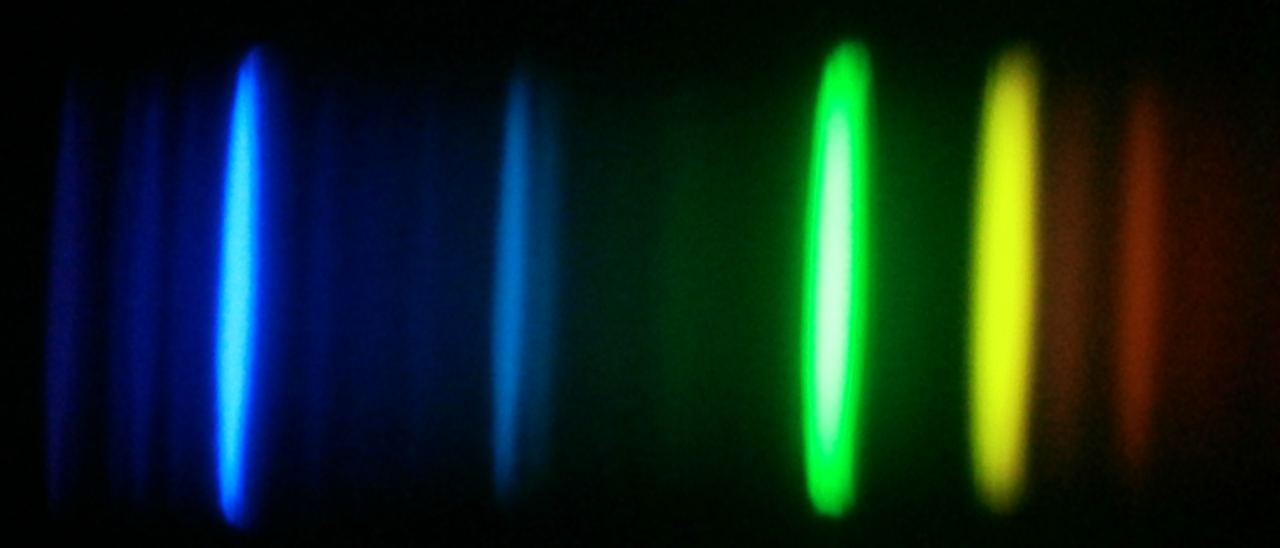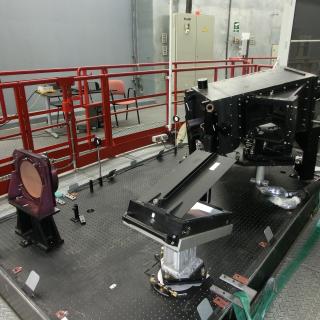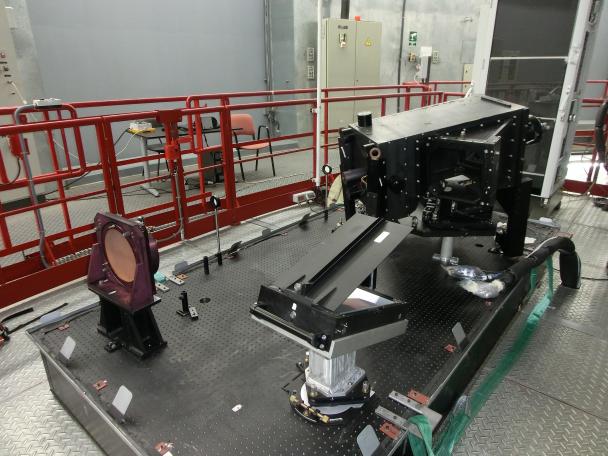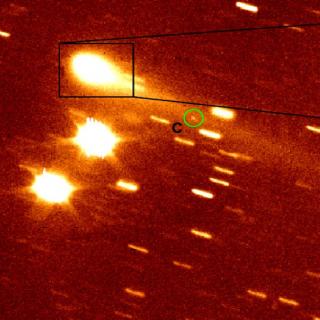Grants related:
General
Stellar spectroscopy allows us to determine the properties and chemical compositions of stars. From this information for stars of different ages in the Milky Way, it is possible to reconstruct the chemical evolution of the Galaxy, as well as the origin of the elements heavier than boron, created mainly in stellar interiors. It is also possible to study stellar formation, and the formation of the Galaxy, from the signature of the Galactic potential on the stellar orbits, and the distributions of mass, ages, and the abundance of heavy elements.
Obtaining high-resolution spectra, as necessary for studies of chemical compositions, requires advanced and efficient instrumentation. This is particularly true for research that calls for large stellar samples, which demands the observation of hundreds or thousands of sources simultaneously. Efficiency requires that the data processing and analysis are performed in an automated way.
The interpretation of spectra is based on physical models of the atmospheres of the stars, from where the light that we observe escapes the stars. The main ingredients for building such models are the fluid dynamics, and the properties of the atoms, ions, and molecules, especially regarding their interactions with the radiation coming from the stellar interior.
Once we have a plausible model, it is possible to compute in detail how the radiation propagates through the stellar atmosphere, and the emergent spectrum, which can then be iteratively compared with the observations to refine the model.
This project covers three different research fronts:
- Improving model atmospheres and simulations of stellar spectra.
- Developing tools for acquisition, reduction, and analysis of spectroscopic observations, in particular for the determination of chemical abundances in stars.
- Designing, preparing, and executing spectroscopic studies of stars aimed at understanding a) the most relevant aspects of the physics of stellar atmospheres, b) the formation and evolution of stars, c) the origin of the chemical elements, and d) the formation, structure, and evolution of the Milky Way galaxy.
Members
Results
- Complete the installation and commissioning of HORuS on GTC
- Discover two new stars with more than 100,000 times less iron than the Sun
- Complete the classification of all the APOGEE spectra with K-means
- Publish a complete collection of model stellar spectra for stars O to M
- Identify the signature of chemical diffusion in the atmospheres of the stars in the cluster M67
Scientific activity
Related publications
-
The APOGEE Data Release 16 Spectral Line List
The updated H-band spectral-line list (from λ15000-17000) adopted by the Apache Point Observatory Galactic Evolution Experiment (APOGEE) for the SDSS-IV Data Release 16 (DR16) is presented in this work. The APOGEE line list is a combination of atomic and molecular lines, with data drawn from laboratory, theoretical, and astrophysical sources
Smith, Verne V. et al.Advertised on:
62021 -
Six transiting planets and a chain of Laplace resonances in TOI-178
Determining the architecture of multi-planetary systems is one of the cornerstones of understanding planet formation and evolution. Resonant systems are especially important as the fragility of their orbital configuration ensures that no significant scattering or collisional event has taken place since the earliest formation phase when the parent
Leleu, A. et al.Advertised on:
52021 -
The pristine dwarf-galaxy survey - III. Revealing the nature of the Milky Way globular cluster Sagittarius II
We present a new spectroscopic study of the faint Milky Way satellite Sagittarius II. Using multiobject spectroscopy from the Fibre Large Array Multi-Element Spectrograph, we supplement the data set of Longeard et al. with 47 newly observed stars, 19 of which are identified as members of the satellite. These additional member stars are used to put
Longeard, Nicolas et al.Advertised on:
52021 -
Probing 3D and NLTE models using APOGEE observations of globular cluster stars
Context. Hydrodynamical (or 3D) and non-local thermodynamic equilibrium (NLTE) effects are known to affect abundance analyses. However, there are very few observational abundance tests of 3D and NLTE models. Aims: We developed a new way of testing the abundance predictions of 3D and NLTE models, taking advantage of large spectroscopic survey data
Masseron, T. et al.Advertised on:
32021 -
The atmosphere of HD 209458b seen with ESPRESSO. No detectable planetary absorptions at high resolution
We observed two transits of the iconic gas giant HD 209458b between 380 and 780 nm, using the high-resolution ESPRESSO spectrograph. The derived planetary transmission spectrum exhibits features at all wavelengths where the parent star shows strong absorption lines, for example, Na I, Mg I, Fe I, Fe II, Ca I, V I, Hα, and K I. We interpreted these
Casasayas-Barris, N. et al.Advertised on:
32021 -
Analysis of Previously Classified White Dwarf-Main-sequence Binaries Using Data from the APOGEE Survey
We present analyses of near-infrared spectroscopic data from the Apache Point Observatory Galactic Evolution Experiment (APOGEE) survey for 45 previously confirmed or candidate white dwarf-main-sequence (WDMS) binaries identified by the optical Sloan Digital Sky Survey (SDSS) and LAMOST surveys. Among these 45 systems, we classify three as having
Corcoran, Kyle A. et al.Advertised on:
32021 -
Fundamental physics with ESPRESSO: Towards an accurate wavelength calibration for a precision test of the fine-structure constant
Observations of metal absorption systems in the spectra of distant quasars allow one to constrain a possible variation of the fine-structure constant throughout the history of the Universe. Such a test poses utmost demands on the wavelength accuracy and previous studies were limited by systematics in the spectrograph wavelength calibration. A
Schmidt, Tobias M. et al.Advertised on:
22021 -
ESPRESSO high-resolution transmission spectroscopy of WASP-76 b
Aims: We report on ESPRESSO high-resolution transmission spectroscopic observations of two primary transits of the highly irradiated, ultra-hot Jupiter-sized planet, WASP-76b. We investigated the presence of several key atomic and molecular features of interest that may reveal the atmospheric properties of the planet. Methods: We extracted two
Tabernero, H. M. et al.Advertised on:
22021 -
The GTC gains high spectral resolution
HORuS, a new high-resolution spectrograph for the Gran Telescopio Canarias, will facilitate an expanded range of optical and near-infrared studies, explains Instrument Scientist Carlos Allende Prieto.
Allende Prieto, CarlosAdvertised on:
02021 -
ESPRESSO at VLT. On-sky performance and first results
Context. ESPRESSO is the new high-resolution spectrograph of ESO's Very Large Telescope (VLT). It was designed for ultra-high radial-velocity (RV) precision and extreme spectral fidelity with the aim of performing exoplanet research and fundamental astrophysical experiments with unprecedented precision and accuracy. It is able to observe with any
Pepe, F. et al.Advertised on:
12021 -
Evidence from APOGEE for the presence of a major building block of the halo buried in the inner Galaxy
We report evidence from APOGEE for the presence of a new metal-poor stellar structure located within ∼4 kpc of the Galactic Centre. Characterized by a chemical composition resembling those of low-mass satellites of the Milky Way, this new inner Galaxy structure (IGS) seems to be chemically and dynamically detached from more metal-rich populations
Horta, Danny et al.Advertised on:
12021 -
The contribution of N-rich stars to the Galactic stellar halo using APOGEE red giants
The contribution of dissolved globular clusters (GCs) to the stellar content of the Galactic halo is a key constraint on models for GC formation and destruction, and the mass assembly history of the Milky Way. Earlier results from APOGEE pointed to a large contribution of destroyed GCs to the stellar content of the inner halo, by as much as 25 ${{\
Horta, Danny et al.Advertised on:
12021 -
The S2 stream: the shreds of a primitive dwarf galaxy
The S2 stream is a kinematically cold stream that is plunging downwards through the Galactic disc. It may be part of a hotter and more diffuse structure called the Helmi stream. We present a multi-instrument chemical analysis of the stars in the metal-poor S2 stream using both high- and low-resolution spectroscopy, complemented with a re-analysis
Aguado, David S. et al.Advertised on:
12021 -
Atmospheric Rossiter-McLaughlin effect and transmission spectroscopy of WASP-121b with ESPRESSO
Context. Ultra-hot Jupiters are excellent laboratories for the study of exoplanetary atmospheres. WASP-121b is one of the most studied; many recent analyses of its atmosphere report interesting features at different wavelength ranges. Aims: In this paper we analyze one transit of WASP-121b acquired with the high-resolution spectrograph ESPRESSO at
Borsa, F. et al.Advertised on:
12021 -
Chemical composition of the solar surface
The Sun provides a standard reference against which we compare the chemical abundances found anywhere else in the Universe. Nevertheless, there is not a unique `solar' composition, since the chemical abundances found in the solar interior, the photosphere, the upper atmosphere, or the solar wind, are not exactly the same. The composition of the
Allende Prieto, CarlosAdvertised on:
122020 -
WASP-127b: a misaligned planet with a partly cloudy atmosphere and tenuous sodium signature seen by ESPRESSO
Context. The study of exoplanet atmospheres is essential for understanding the formation, evolution, and composition of exoplanets. The transmission spectroscopy technique is playing a significant role in this domain. In particular, the combination of state-of-the-art spectrographs at low- and high-spectral resolution is key to our understanding of
Allart, R. et al.Advertised on:
122020 -
HADES RV programme with HARPS-N at TNG. XII. The abundance signature of M dwarf stars with planets
Context. Most of our current knowledge on planet formation is still based on the analysis of main sequence, solar-type stars. Conversely, detailed chemical studies of large samples of M dwarfs hosting planets are still missing. Aims: Correlations exist between the presence of different types of planets around FGK stars and metallicity, individual
Maldonado, J. et al.Advertised on:
122020 -
Broadband transmission spectroscopy of HD 209458b with ESPRESSO: evidence for Na, TiO, or both
Context. The detection and characterization of exoplanet atmospheres is currently one of the main drivers pushing the development of new observing facilities. In this context, high-resolution spectrographs are proving their potential and showing that high-resolution spectroscopy will be paramount in this field. Aims: We aim to make use of ESPRESSO
Santos, N. C. et al.Advertised on:
122020 -
The S2 stream: the shreds of a primitive dwarf galaxy
The S2 stream is a kinematically cold stream that is plunging downwards through the Galactic disc. It may be part of a hotter and more diffuse structure called the Helmi stream. We present a multi-instrument chemical analysis of the stars in the metal-poor S2 stream using both high- and low-resolution spectroscopy, complemented with a re-analysis
Aguado, David S. et al.Advertised on:
102020 -
Evidence from APOGEE for the presence of a major building block of the halo buried in the inner Galaxy
We report evidence from APOGEE for the presence of a new metal-poor stellar structure located within ∼4 kpc of the Galactic Centre. Characterized by a chemical composition resembling those of low-mass satellites of the Milky Way, this new inner Galaxy structure (IGS) seems to be chemically and dynamically detached from more metal-rich populations
Horta, Danny et al.Advertised on:
112020
Related talks
No related talks were found.Related conferences
No related conferences were found.News
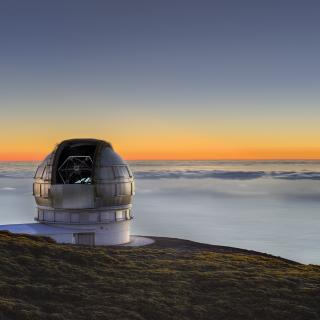
The IAC is an internationalized Spanish research centre aiming to achieve major advances in the understanding of the laws that govern the origin and evolution of the various forms of matter/energy in the Universe. Outstanding results are expected in key areas of research such as Solar physics, Sun-Earth connections, Exoplanetary systems, Solar
